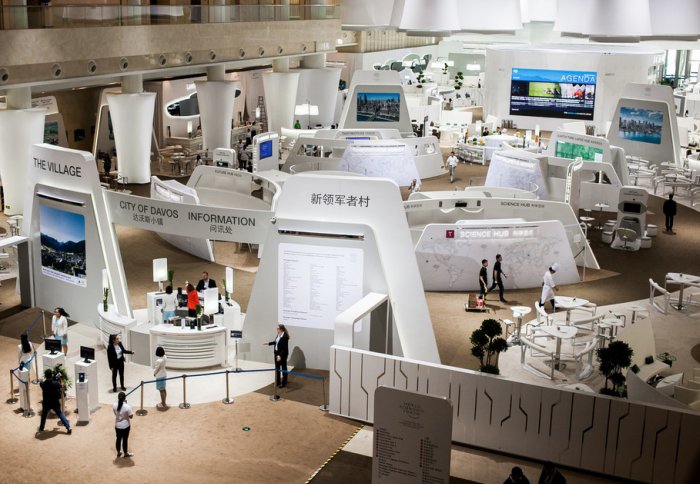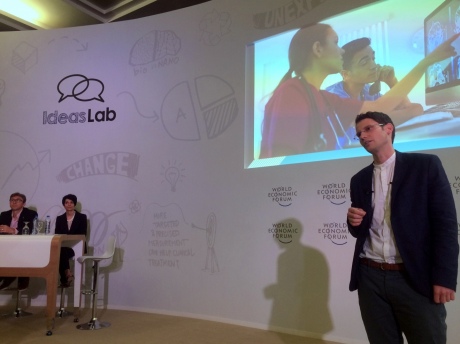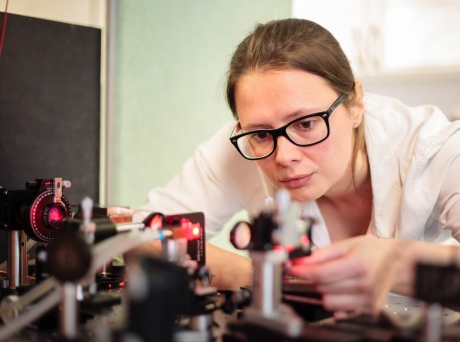

The future of imaging in driving the 'fourth industrial revolution' was presented by a group of young Imperial researchers in China this week.
Researchers from Imperial College London presented a special IdeasLab session at the World Economic Forum to a gathering of global government, industry and NGO leaders. They described how advances in imaging are driving innovation in medical diagnosis and surgery as well as global farming and visions of the most fundamental processes in nature.
The opportunity for us at Imperial is in part to create the new instruments of science that will launch new industrial revolutions.
– Professor David Gann
Vice President (Innovation)
Following on from Imperial’s involvement in the World Economic Forum annual meeting in Davos, Switzerland earlier this year, this week four researchers presented their ideas at WEF’s Annual Meeting of the New Champions in Tianjin, China.
The World Economic Forum’s theme this year is the ‘fourth industrial revolution’: the set of technological changes that will enable almost anyone to invent new products and services quickly and cheaply, such as 3D printing and nanotechnology.
Professor David Gann, Imperial’s Vice President (Innovation), who wrote a blog for the WEF warning big businesses that they should avoid roadblocks to innovation, introduced Imperial’s speakers. He said: “The opportunity for us at Imperial is in part to create the new instruments of science that will launch new industrial revolutions.”
“Each one of our speakers today gave really nice examples of where we might find useful and important purpose from deep science, illustrating 'sat navs' for atoms, brains, bodies and the planet.”
Battling brain disease
Dr Stamatia Giannarou from Imperial’s Department of Computing spoke about her research into real-time imaging that could guide brain surgeons – helping them remove tumours without damaging other areas of the brain.
She described the problem: “Even with the best surgery, brain cancers still kill more children and adults under the age of 40 than any other cancer. To fix this, we need to help surgeons navigate much better through the delicate pathways of the brain. In fact, we need to give the surgeon a SatNav.”
Dr Giannarou is working to combine imaging systems that look at the microscopic details of the boundaries between tumour and healthy tissue, with techniques for looking at the larger-scale structures that support brain functions like speech and movement.

Dr Ben Glocker presents his research on AI and brain injury
Dr Ben Glocker, also from the Department of Computing at Imperial, focuses on imaging and diagnosing brain injury. Instead of improving the imaging itself, however, he is working on a better way of interpreting brain scans, using artificial intelligence.
He said: “Without the right information, at the right time, there is a real risk that critical patterns of disease go undetected. And yet piecing it together is incredibly challenging. We’re asking: What if we could train a computer to help read these complex, multi-scan images? Could a machine find the patterns that humans find hard to see?”
The team have already created a machine that can learn the structures of the brain itself, build precise 3D maps and identify lesions.
Shedding laser light on problems big and small
Two researchers form Imperial’s Department of Physics presented their work in using lasers to understand processes on the scales of atoms and the scale of entire farms.
Dr Tobias Witting works in attosecond science – using extremely fast laser pulses to understand chemical processes that last on a billion billionth of a second.
He explained the applications of this research: “Imagine being able to engineer an artificial leaf that can harvest light to produce electricity or biofuel. To fully understand processes like this, we need to be able to see what is going on at the super-fast, super-small scale of electrons.”
Using extremely fast pulses of laser light to snap images of molecules during reactions, Dr Witting and his team are learning how, and how fast, the transitions between chemical states occur.

Dr Gabrielle Thomas working with lasers
Dr Gabrielle Thomas is using lasers for a much larger-scale problem: precision farming. She explained what precision farming is: “The better you target your use of water, fertilizer and herbicides, even down to the level of individual plants, the less you waste and the smaller your resource footprint.
“The interesting part is not just figuring out what one plant needs, but doing it at the scale of a million plants. This is where imaging can help, capturing the detail but from a distance.”
Dr Thomas is working on lasers than can be mounted on satellites and provide information about plant health to farmers worldwide, making the benefits available to all and hopefully helping us reach the UN Food and Agriculture Organisation’s target of producing 70 percent more food by 2050.
Article text (excluding photos or graphics) available under an Attribution-NonCommercial-ShareAlike Creative Commons license.
Photos and graphics subject to third party copyright used with permission or © Imperial College London.
Reporter
Hayley Dunning
Communications Division

Contact details
Tel: +44 (0)20 7594 2412
Email: h.dunning@imperial.ac.uk
Show all stories by this author




Leave a comment
Your comment may be published, displaying your name as you provide it, unless you request otherwise. Your contact details will never be published.